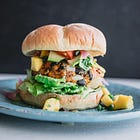
🟡 A Big Welcome to Our New Subscribers!
If you’re new here . . . welcome to Plant-Based Times! We’re thrilled to have you. Whether you’re plant-curious, or vegan committed, you’re in the right place. Let’s dig in.
Ah, the age-old question: where do you get your protein? It’s the plant-based community’s version of “How about that weather?” Let’s settle it once and for all: complete protein isn’t a myth, but the way we talk about it often is.
🟡 Protein Panic
First, let’s get our definitions straight. Protein is made up of amino acids, nine of which are deemed essential because our bodies can’t make them on their own. These nine essential amino acids are what the “complete protein” debate is all about.
The claim: Meat (and fish, and poultry) offers all nine essential amino acids in sufficient quantities as standalone foods, making them the ‘better’ protein sources.
The truth: While this is technically accurate that animal products offer all nine essential amino acids in one product, it misses the bigger picture. You don’t need every amino acid in one bite.
Your body is perfectly capable of mixing and matching from the foods you eat throughout the day.
Rice and beans, the staple combo of cuisines worldwide, are a prime example of complementary proteins.
Together, they form a nutritional portfolio that checks all the boxes.
And here’s a bonus: many plants, including quinoa, soy, and even buckwheat, are already complete on their own.
🟡 Meat Your Match
The myth isn’t that plant proteins are incomplete; it’s the idea that they’re somehow inferior.
If the nutrients are present and bioavailable, your body will use them.
It doesn’t care whether your amino acids come from lentils or lamb. What matters is variety.
Eat a diverse diet, and you’ll hit your targets without breaking a sweat.
🟡 Are We Overthinking It?
Let’s address another myth: the idea that everyone needs to obsess over protein. Unless you’re a top-tier performance athlete, or subsisting on a diet of Oreos and warm water . . . you’re probably fine.
Fruits, leafy greens, vegetables, grains, and legumes all contain protein, and it’s surprisingly hard to miss your daily requirements if you’re eating enough calories from whole, plant-based foods.
Even rice and beans individually are complete proteins, so the odds are stacked in your favor.
Need convincing? Research has repeatedly shown that vegan and omnivorous diets support comparable muscle protein synthesis rates when protein needs are met. Translation: you can get swole on plants, too.
🟡 Fiber Factor
Here’s something to chew on: why aren’t we as obsessed with fiber as we are with protein? Most people don’t hit their daily fiber goals, and it’s arguably just as important (if not more so) for overall health.
Fiber’s benefits include better digestion, lower cholesterol, and improved gut health . . .things a protein shake can’t do.
🟡 Cover Your Bases
Transitioning to a plant-based diet? A little prep goes a long way. Dr. Greger’s How Not to Die and Dr. Bulsiewicz’s Fiber Fueled are excellent resources.
And don’t forget . . . we’ve got you covered with detailed posts on macronutrients:
🟡 Resources for the Curious
🟡 The Last Word
Complete protein isn’t a myth, but the anxiety around it should be. If you’re eating a varied plant-based diet with plenty of whole foods, you’ll get all the amino acids and protein you need.









Thanks for this! I have a question though. You mention combining different plant based foods to create the right amino acid profile, but how much do you need of the amino acids to be sure you aren't deficient?